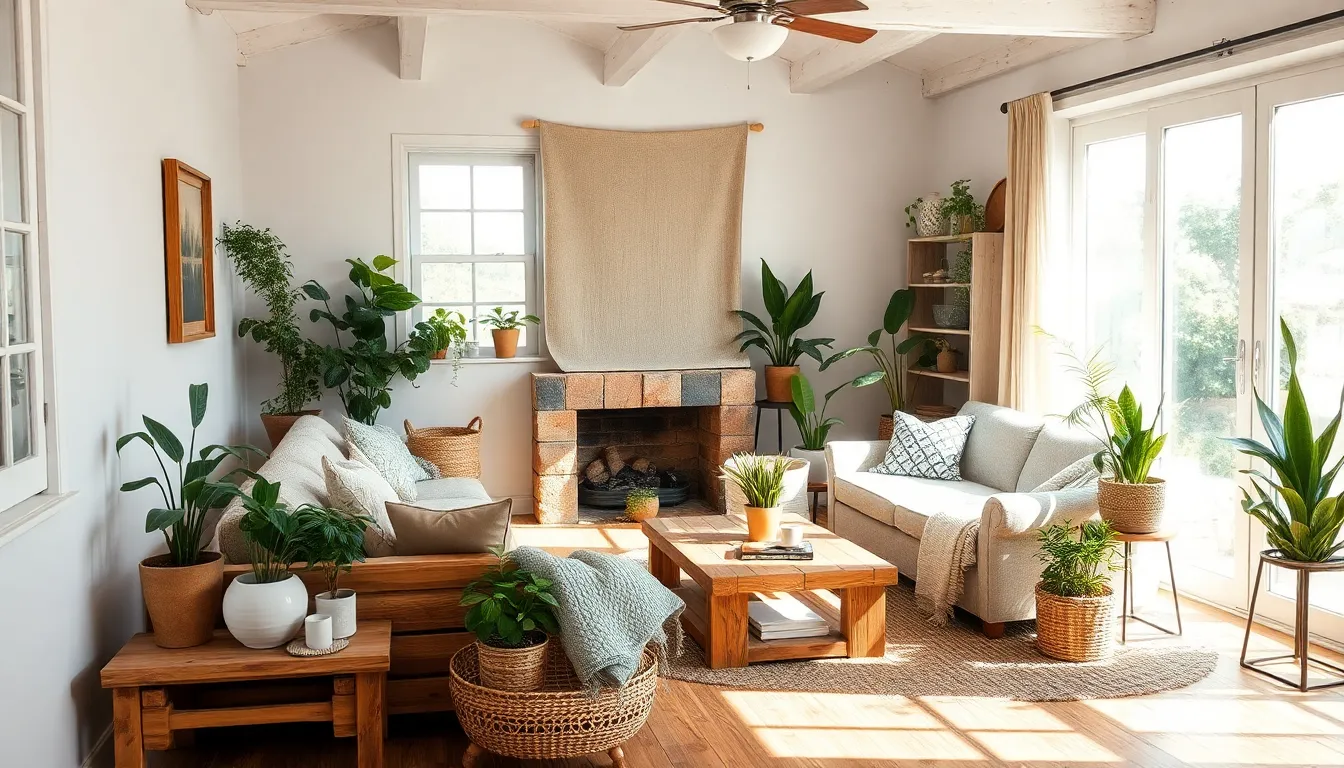Table of Contents
ToggleIn a world where fast furniture and disposable decor reign supreme, sustainable decor is the stylish rebel that’s here to save the day. Imagine transforming your living space into a sanctuary that not only looks good but also feels good—like a cozy hug for the planet. Sustainable decor isn’t just a trend; it’s a lifestyle choice that says “I care” while keeping your home chic and inviting.
From reclaimed wood tables to eco-friendly textiles, sustainable decor proves that being kind to Mother Earth doesn’t mean sacrificing style. It’s time to swap out that mass-produced monstrosity for unique pieces that tell a story. So, grab your favorite plant and let’s dive into the wonderful world of sustainable decor, where every choice you make is a step toward a greener future and a home that reflects your values.
What Is Sustainable Decor?
Sustainable decor incorporates eco-friendly materials and practices into interior design. It focuses on long-lasting pieces that minimize environmental impact while enhancing aesthetic appeal. Designers prioritize items made from reclaimed wood, recycled metals, and organic textiles, ensuring each element contributes to a healthier planet.
Emphasis on natural resources drives the selection of furnishings and accessories. For example, bamboo, a rapidly renewable resource, serves as an excellent choice for flooring and furniture. Many homeowners opt for vintage or second-hand items, which not only reduce waste but also add character to spaces.
In addition, sustainable decor promotes mindful consumption. By choosing high-quality, durable products, individuals can avoid the cycle of fast furniture that often ends up in landfills. Often, it highlights craftsmanship and unique designs that tell a story, connecting the owner to the origins of each piece.
Sustainable decor also encompasses energy efficiency. Utilizing LED lighting and energy-efficient appliances can significantly lower utility bills while reducing carbon footprints. Incorporating indoor plants into design not only beautifies spaces but also improves air quality.
To fully embrace sustainable decor, they integrate local and artisan products. Supporting local craftspeople not only brings unique, handmade items into spaces but also bolsters community economies. Ultimately, this conscious approach to decorating fosters a lifestyle aligned with environmental values, making homes more inviting while protecting the planet.
Benefits Of Sustainable Decor

Sustainable decor offers numerous advantages that extend beyond aesthetics. Its positive effects benefit both the environment and individual lifestyles.
Environmental Impact
Sustainable decor significantly reduces waste through the use of eco-friendly materials. Reclaimed wood and recycled metals minimize the demand on natural resources. Implementing sustainable practices lowers carbon footprints by promoting energy-efficient appliances and LED lighting. Communities also benefit as local artisans thrive from purchases of handmade items. Collective efforts to embrace sustainable decor contribute to a healthier planet for future generations.
Health Advantages
Sustainable decor improves indoor air quality through the incorporation of natural materials and indoor plants. Organic textiles contribute to reduced allergens and harmful chemicals in living spaces. Spaces that utilize sustainable decor often reflect a commitment to well-being. Mindful selections of furnishings promote healthier lifestyles by creating serene environments. Health-conscious choices in decor lead to enhanced comfort and reduced stress in daily living.
Key Materials In Sustainable Decor
Sustainable decor utilizes materials that minimize environmental impact while enhancing aesthetics. Key materials include recycled and natural elements, which contribute to eco-friendly living spaces.
Recycled Materials
Recycled materials play a significant role in sustainable decor. Designers often use reclaimed wood for furniture, providing unique character to each piece. Recycled metals, such as aluminum and steel, are favored for their durability and low environmental impact. Glass products also find new life in decor, ranging from light fixtures to decorative accents. These materials promote a circular economy by reducing waste and conserving resources. Opting for items crafted from recycled materials supports a sustainable lifestyle while adding charm to interiors.
Natural Elements
Natural elements form the foundation of eco-friendly decor. Bamboo serves as an excellent choice, known for its rapid growth and renewability. Organic textiles, made from cotton, linen, and hemp, ensure that homes remain free from harmful chemicals. Stone and clay frequently appear in decor, adding a rustic yet elegant touch to spaces. Incorporating plants further enhances natural aesthetics, improving air quality and creating a calming atmosphere. Using natural elements fosters a connection to the environment while promoting an inviting home.
Tips For Implementing Sustainable Decor
Integrating sustainable decor into living spaces enhances both aesthetics and environmental consciousness. Practical strategies help create eco-friendly sanctuaries.
Incorporating Vintage Pieces
Embracing vintage pieces adds character and uniqueness to interior designs. Not only do these items often carry history, but they also contribute to sustainability by reducing demand for new materials. Vintage furniture and accessories typically feature durable construction, allowing for long-term use. Exploring local thrift stores and antique shops presents opportunities to discover one-of-a-kind finds. Selecting these treasures also minimizes waste, promoting a circular economy where items circulate rather than end up in landfills. Combining vintage elements with modern designs creates stylish contrasts that reflect individual tastes.
Choosing Eco-Friendly Brands
Focusing on eco-friendly brands supports sustainable practices and responsible manufacturing. Many companies prioritize using recycled materials and organic textiles in their products. Researching certifications, such as Fair Trade and Global Organic Textile Standard, ensures that purchases align with ethical standards. Supporting local artisans creates meaningful connections while fostering community economies. Identifying brands that practice transparency in their supply chains allows consumers to make informed choices. Prioritizing eco-conscious brands ultimately leads to healthier living environments and a positive impact on the planet.
Popular Sustainable Decor Trends
Sustainable decor trends reflect a growing commitment to eco-friendly living. Furniture crafted from reclaimed wood exemplifies this commitment, offering both quality and character. Consumers gravitate toward recycled metals and glass, which promote a circular economy while delivering unique design options.
Natural elements also play a significant role in contemporary decor. Bamboo’s versatility makes it a popular choice for flooring and furniture, adding a warm aesthetic while being highly renewable. Organic textiles further enhance the appeal of sustainable interiors; they provide a soft touch while ensuring the use of non-toxic materials.
Indoor plants have gained popularity for their ability to purify air. Engaging with nature indoors increases tranquility and enhances well-being. Homeowners often combine various plant types to create living art that transforms spaces.
Energy efficiency forms another critical aspect of sustainable decor. Selecting LED lighting options reduces energy consumption and lowers utility costs, contributing to a smaller carbon footprint. Many are exploring the integration of energy-efficient appliances in kitchens, promoting sustainability through smart choices.
Artisan products reflect local craftsmanship, making them ideal for adding uniqueness to decor. Supporting local economies fosters community connections while showcasing handmade items. Vintage pieces also experience a resurgence; they bring history and charm into modern homes while minimizing waste.
Popular sustainable decor trends hinge on unique materials, energy efficiency, and community support. These trends not only beautify living spaces but foster a deeper connection to environmental values and healthier lifestyles.
Sustainable decor offers a refreshing approach to interior design that aligns style with environmental responsibility. By prioritizing eco-friendly materials and mindful consumption, individuals can create beautiful spaces that reflect their values. This commitment not only enhances living environments but also supports local artisans and promotes a healthier planet.
Embracing sustainable practices in decor leads to long-lasting benefits. With each carefully chosen piece, homeowners contribute to a circular economy while enjoying unique designs that tell a story. The journey toward sustainable living begins with small changes that make a significant impact, transforming homes into eco-friendly havens.







